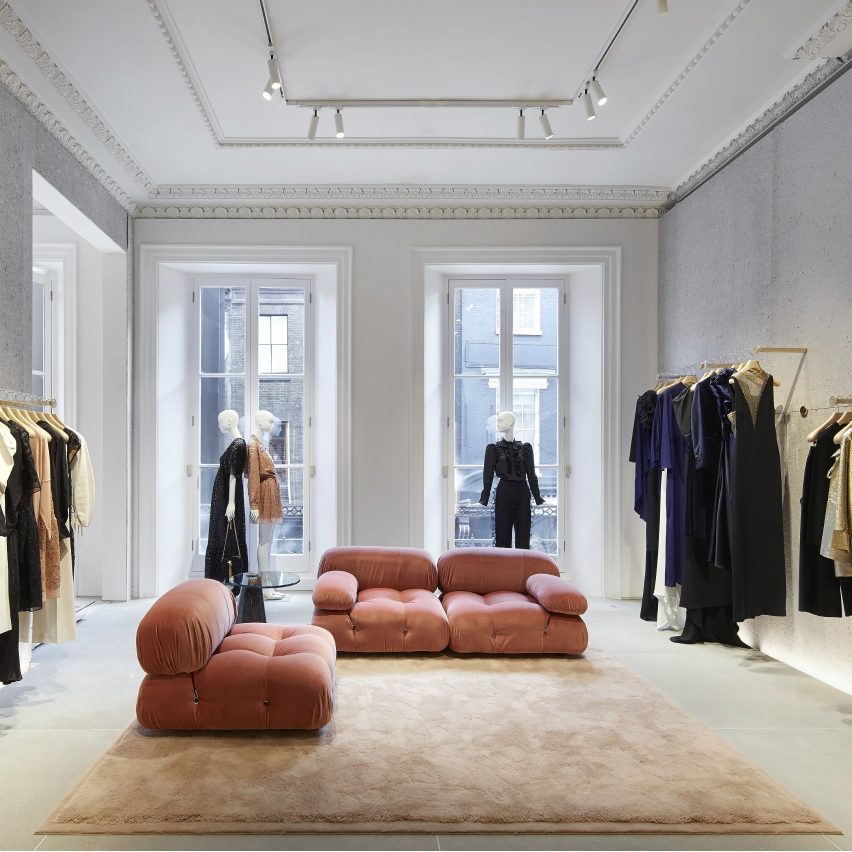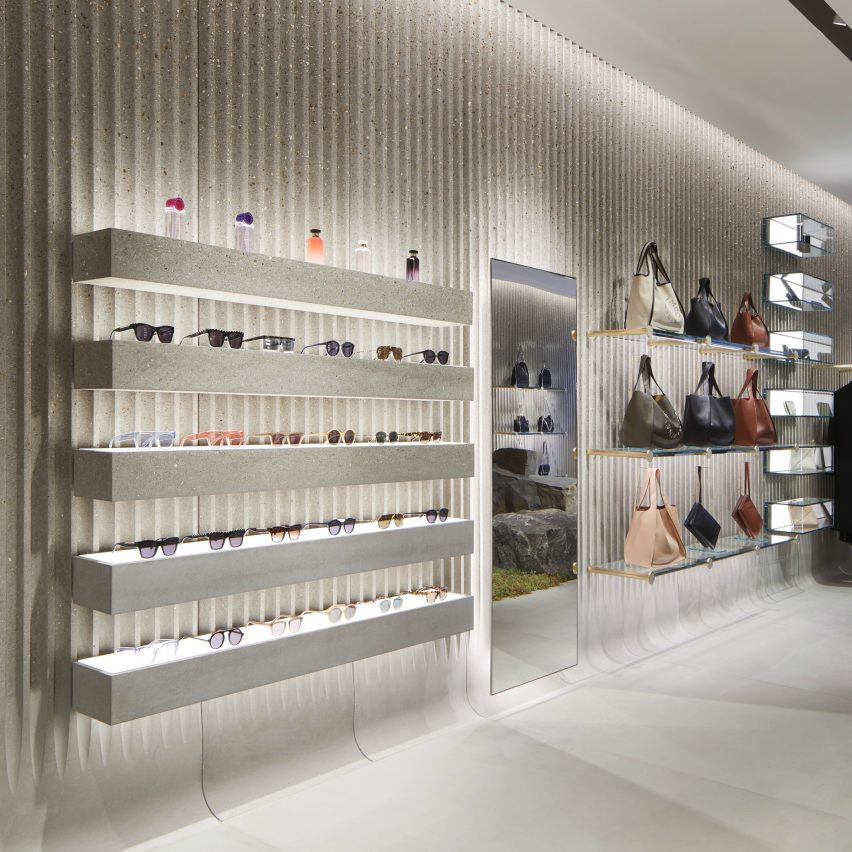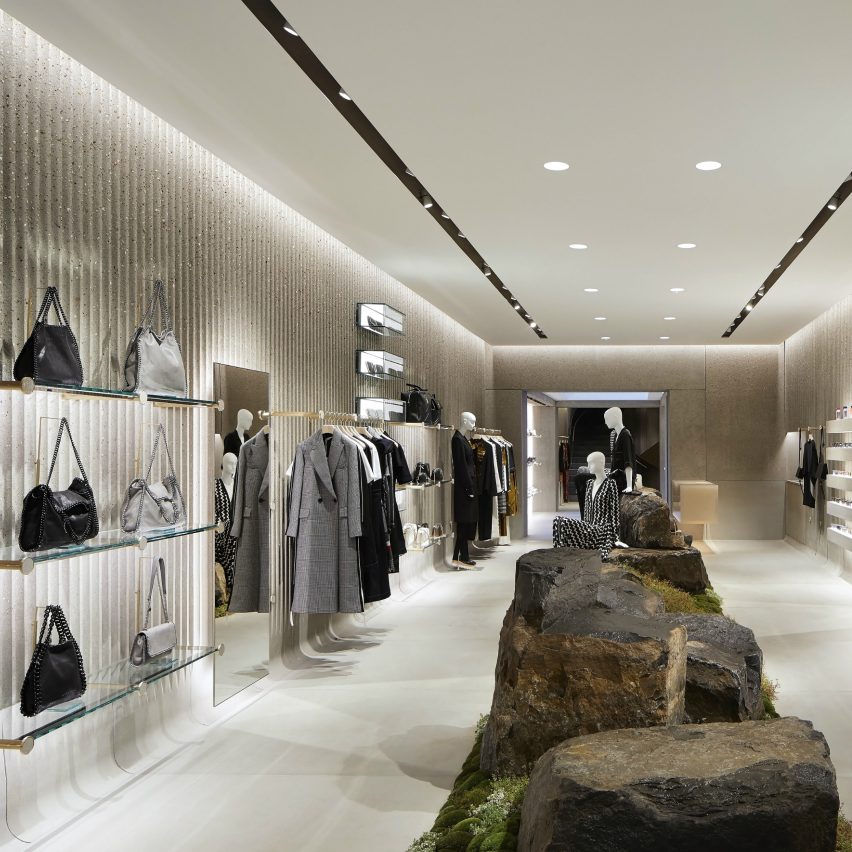
"Designers aren't taking responsibility" says Stella McCartney
In an exclusive interview, Stella McCartney sets out her environmental mission, and explains how it influenced her to design her latest store – with a little help from her dad.
Speaking to Dezeen at her newly opened London flagship store, the British fashion designer explained her frustrations with other designers and how she believes a movement towards sustainable materials is necessary.
"If everyone in the design world created a more sustainable product with more mindfulness, then it wouldn't even be a conversation," she said. "But they're not."
For her new store on Old Bond Street – the flagship for the McCartney label – the designer has incorporated multiple references to her childhood and her famous parents, legendary musician Paul McCartney, and the late musician, photographer and animal-rights activist Linda McCartney.
But she also chose to take a sustainable approach with every detail, including biodegradable mannequins made from a bioplastic material composed of sugar-cane derivatives and an Airlabs air-filtration system that provides the "cleanest air in London".
"We need to impose new laws on designers" says McCartney
Hoping to lead by example, McCartney, 46, called for other designers to change – and said new laws should be introduced to force them to do so.
"We need to impose new laws on designers because sadly people aren't taking responsibility, and there is no incentive to encourage them," said the designer.
"In order to encourage people to have better practice in their business, to have better product for the planet and the animals who inhabit us with us, then there absolutely should be some laws in place to make it harder for people to screw the planet up."

Last year, McCartney championed a study by the Ellen MacArthur Foundation that called for the fashion industry to rethink the production methods used to make textiles, to radically reduce the amount of waste they produce. This mixture of activism and idealism is typical of her.
"For me as a designer, the minute I make something I think about the planet," she said. "If I really wanted to be an eco warrior I'd just sit at home and only eat stuff out of my garden."
McCartney promotes sustainable materials in fashion
McCartney recently made headlines with her designs for guests at the wedding of Prince Harry and Meghan Markle in May, where she dressed Markle for the reception and Amal Clooney and Oprah Winfrey for the ceremony. She hopes that displaying her use of eco-friendly materials on a global stage will make a lasting impression, and spur more fashion houses to take up these materials.
"When I look at Amal Clooney's dress from the royal wedding, that is [made from] a sustainable viscose. Viscose is made from trees and 150 million of them are cut down each year in the name of fashion," she said.

Each year, the equivalent of 48 football pitches full of trees are cut down and turned into a cellulosic fabric which is woven into viscose. As an environmentally friendly alternative, McCartney works with Canopy, a non-profit organisation, to source the raw pulp which forms the cellulosic fabric from a sustainably certified forest in Sweden.
"I spent three years of my life dedicated to finding trees from a sustainable wood and we wove that with mills that make conventional viscose. We had to train them and they resisted at first, but we persevered and now we've done it," McCartney explained.
"I call and beg every designer to replace their viscose with my sustainable one. If I can do it, anyone can do it."
McCartney's passion for sustainability comes from parents
McCartney attributes both her love of fashion and her passion for sustainability to her vegetarian parents, who raised her on a farm in Scotland.
"I wanted to be a designer from a really young age. Some of my earlier memories are when I used to sit in my parents wardrobe and look at their stage gear from Wings," she said, referencing the band her parents formed and performed in from 1971 to 1982.
"I would get transfixed and totally obsessed with my mum's sparkly platform heels or my dad's bespoke suits."
She said that she would never consider using animal products in her fashion designs.
"I grew up as a vegetarian so I've always thought, why would I kill an animal to make a shoe but I wouldn't kill it to digest it? Morally that is hypocritical," she said.
"I'm sure you would go into any store and think that my bags are real leather, and for me that's really funny and cool. I think that's quite punk rock. My parents were a Liverpudlian and a New Yorker coming together and not taking any shit. For me, I'm not going to be apologetic."

The fashion designer trained at Central Saint Martins in London before taking up her first job working for tailor Tommy Nutter on Saville Row.
After a stint of internships working for designers including Christian Lacroix, McCartney launched her fashion house in 2001 as a joint venture with Kering, the company which owns Gucci, Balenciaga and Saint Laurent among others.
In April this year, McCartney bought out Kering, giving herself full ownership of the House of Stella McCartney for the first time.
She has also been involved in many high-profile design collaborations, including working with Adidas to design the Team GB kits for both the London 2012 Olympics and the Rio 2016 Olympics. She and the brand also teamed up with Parley for the Oceans to create a range of trainers made from ocean plastic.
Paul McCartney worked with Stella on new store design
Alongside a passion for sustainability and a self-confession desire to save the planet, McCartney has a more unexpected love – architecture. She led the design of her store at 23 Old Bond Street – transforming a Grade-II listed 18th-century building into a shiny four-storey architectural experience connected by a raw steel spiral staircase.
The design is filled with references to McCartney's parents, and her father even worked alongside her in its creation.

Three-foot tall boulders from the family farm in Kintyre, Scotland, sit on the concrete floors, contrasted against brightly coloured recycled foam seating, a squidgy orange silicon desk and reclaimed Venetian wood that serves as shelving.
Paul McCartney's old vinyl player sits in the menswear department on the fourth floor, and visitors are invited to play his records.
A soundtrack of unpublished music composed by the former Beatle is also played through speakers behind mirrors and from the ceiling above the spiral steel staircase.
"Audio has such weight and magnitude in my life, probably not like for normal people," said McCartney.
"I want anyone to come to this store, whether you're rich, poor, black, white, old, young, male or female. Anyone can come. I don't need you to buy anything, I just want you to come and experience the store and listen to the music."

The main focal point of the store, the steel staircase, has caused much contention among the Stella McCartney team, as it eats into valuable retail space. She was advised to create a small staircase to maximise the surface area of her shop floors, but McCartney pushed back.
"We've given up a lot of retail space in the store to create an architectural experience," she stated.
"Architecture is a huge passion of mine and I have been the architect in this process of creating this space. You are only allowed to do so much architecture in retail because you are limited in that people have to do a certain amount of shopping."
McCartney hopes that the sustainable elements of her new store, which slot in around the striking visual elements, will urge other designers to incorporate environmental thinking into their work.
"This is not easy for me and these shoulder-padded-shoulders to do. I'm trying to lead by example, I'm not making a sacrifice and I'm trying not to preach," she added. "It's exhausting full stop, but we believe it and we do it and we won't stop."
Below is an edited transcript of the interview:
Emily Wadsworth: Tell us about the design of your store. What is the concept?
Stella McCartney: Welcome to the House of Stella McCartney! The experience of the store is so emotional, there is so much in it. It's all about who I am, my life and what I want to say. It's really an ever- changing experience. There is my picture by Sir Peter Blake who is my godfather, that's a picture of my mum and dad that was given to me by them. There's a Wolfgang Tillmans; there's an Erté piece. I met him once on a plane and went and interned for him when I was younger. There's a picture of me and Kate [Moss] when I was just starting out. A Warhol, a Tracey Emin...
Emily Wadsworth: Last year you teamed up with Ellen MacArthur to tackle the "incredibly wasteful" fashion industry. What are your main concerns with the industry and have things moved on from last year?
Stella McCartney: Everyone has the power to make a change. Every single interaction that we have as humans can have an impact on the planet. When I look at Amal Clooney's dress from the royal wedding, that is a sustainable viscose. Viscose is made from trees and 150 million of them are cut down each year in the name of fashion.
I spent three years of my life dedicated to finding trees from a sustainable wood and we wove that with mills that make conventional viscose. We had to train them and they resisted at first, but we persevered and now we've done that. I call and beg every fashion house to replace their viscose with my sustainable one. If I can do it, anyone can do it.
Now, if more people do it, we can all have better business. We can have lower price points, everyone can flourish. There is no reason why not to. As humans we have gone down the more damaging route, but we can stop and review it and not compromise a product. These shoes aren't leather, they aren't made from harmful glues. They look like a cool pair of shoes to me, I don't know. I'm not killing animals, billions of them aren't being murdered just to make shoes. It kind of seems like a bit of a shitty life for an animal, right? I'm not cutting down forests to make way for their grazing. Grain isn't going through them that could go and feed starving people.
I'm trying to lead by example, I'm not making a sacrifice and I'm trying not to preach. I have a message and I am trying to use humour to convey that. I don't want to do it in a way that beats people up. Do I believe that other fashion houses have the power to make change and have an influence. Of course they do! They can do it daily when they dress celebrities. Everyone knows that! If everyone went into the supermarket and picked organic food then we would be living on a more organic and healthier planet. If everyone in the design world created a more sustainable product with more mindfulness then it wouldn't even be a conversation, but they're not.
If I can do it, anyone can do it
Emily Wadsworth: What would most help fashion and design become more sustainable? Do we need new laws?
Stella McCartney: We need to impose new laws on designers because sadly people aren't taking responsibility, and there is no incentive to encourage them. This is not easy for me and these shoulder-padded-shoulders to do. I only do it because I feel that I believe it and this is my meaning, and my reason to do what I do. Many other people don't feel that way and it's not their fault. In order to encourage people to have better practice in their business, to have better product for the planet and the animals who inhabit us with us, then there absolutely should be some laws in place to make it harder for people to screw the planet up.
Emily Wadsworth: There are photos of your mum and dad around. Did they inform the design of the store?
Stella McCartney: My mum and dad are everywhere, with their love of animals which is in me and has progressed into my more environmental sort of stance. In the music and the audio that you hear around me. In the tailoring that you are looking at, that comes from my training when I worked for tailor Tommy Nutter who was my parent's tailor. There are influences from Notting Hill carnival here too as I'm a Londoner. This contrast between masculine and feminine is very much because of my parent's relationship, and my witnessing that when I was a child. Growing up on an organic farm and experiencing trees and growth.
Emily Wadsworth: Where did this wood come from?
Stella McCartney: This ancient wood from Venice used to prop up houses. I wanted to have warmth, calmness and it's completely reclaimed.
Emily Wadsworth: Why the Venetian wood? The rest of your store is very far from the Venetian gothic style of architecture that springs to mind when I see this.
Stella McCartney: Or you think about it all disappearing under water if we don't sort out our planet. You can look at it in many different ways!
Then look over here. My dad made me a one-off, three-hour long track of unreleased music. Audio has such weight and magnitude in my life, probably not like normal children. I want anyone to come to this store, whether you're rich, poor, black, white, old, young, male or female. Anyone can come. I don't need you to buy anything, I just want you to come and experience the store and listen to the music. We have podcasts playing in the changing rooms, downstairs we have meditation which is very much a reflection of my relationship with my dad. He studied with the Maharishi, I learnt about meditation then and then sadly used it when my mum passed away.
You are only allowed to do so much architecture in retail
Emily Wadsworth: Tell me about the architecture and interior design in the store, and how you came up with the concept and executed it.
Stella McCartney: This contrast between the nature and the hard and the soft, it's so important. There is a masculine element to my architecture in this store. I didn't work with anyone in designing or creating this store, I did it all myself. We had a wall covering intended actually but I came in and saw these raw plaster walls and said no, this is amazing, let's just keep it as it is. The staircase was also meant to be clad but I decided that I just loved the steel skeleton of the structure.
Emily Wadsworth: Why didn't you work with an architect or an interior designer?
Stella McCartney: I've always done things in house. Architecture is a huge passion of mine. It's both terrifying and exciting to me. I set myself ridiculous challenges and have always really enjoyed this process. These rocks are from the farms I grew up on in Scotland.
There is a brutalist architectural element to the store with the concrete and then the rocks, and it's sort of jarring and unsettling. Then to see fabric, it's all mashed up into why I do what I do. I love brutalist architecture. I'm a big fan of brutalist touch points, like how this fluted concrete meets the soft floor. Then the silicon desk, did you feel it? It's so amazing.
Emily Wadsworth: People may assume that you aren't involved in the making or designing of something like this store. They might think that you just tell people what you want and click your fingers and it happens.
Stella McCartney: No not at all! I've been far too involved in the design and architecture of this store, up to a point where it's been a painful experience. It's all been worth it though!
Emily Wadsworth: Would you ever move into architecture?
Stella McCartney: For me, I feel that I have created a piece of architecture here. I have been the architect in this process, creating this space. You are only allowed to do so much architecture in retail because you are limited in that people have to do a certain amount of shopping. To create this is quite a big deal. We've given up a lot of retail space in the store to create an architectural experience. Others would say that this staircase is occupying valuable selling space, but I pushed back on that. For me, I am an architect and interiors designer.
Emily Wadsworth: How did you become a designer?
Stella McCartney: I wanted to be a designer from a really young age. Some of my earlier memories are when I used to sit in my parents wardrobe and look at their stage gear from Wings. I would get transfixed and totally obsessed with my mum's sparkly platform heels or my dad's bespoke suits.
I thought I would go into architecture before I decided on fashion. I went to Central Saint Martins to study and persevered and I'm very fortunate that my career path worked out for me. We are predominantly a female company, actually to the point where it's becoming awkward.
I'm a big fan of brutalist touch points
Emily Wadsworth: When did you first become aware of environmental issues and want to start saving the planet?
Stella McCartney: We could all live as one and complement each other if we let ourselves. I grew up as a vegetarian so I've always thought why would I kill an animal to make a shoe but I wouldn't kill it to digest it? Morally that is hypocritical. I'm sure you would go into any store and think that my bags are real leather, and for me that's really cool and funny. I think that's quite punk rock. My parents were a Liverpudlian and a New Yorker coming together and not taking any shit. For me, I'm not going to be apologetic. I don't really feel like a designer, I'm creating more than just product. I'm creating a conversation and a space to reflect.
Emily Wadsworth: Tell me about the vegetarian materials you use, such as ocean plastics?
Stella McCartney: I use recycled plastics, vegetable oils, the list really goes on and on. I don't use glues that contain fish bones of anything, and I'm probably the only designer in the world doing that. We have a company canteen where we feed everyone vegetarian and vegan food. It's a huge part of our brand ethos here at the House of Stella McCartney. We worked with Air Labs to create the store, and I'm proud to say that it has the cleanest air in London, as it filters would nearly 100 per cent of harmful air pollutants.
Emily Wadsworth: That ethos must be challenging to maintain?
Stella McCartney: It's exhausting full stop, but we believe it and we do it and we won't stop. We are trying to create a new palette. The fashion industry works with the same 10 materials and we are questioning that. Things have got to change. Those 10 materials aren't good for the planet and we can create an alternative together. Those two people who just walked in haven't got a clue, and that's so sad to me. You have to tell my story.
Pretty much everything we make has a negative impact on the planet. For me as a designer, the minute I make something I think about the planet. If I really wanted to be an eco warrior I'd just sit at home and I'd only eat stuff out of my garden.